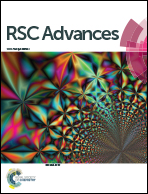The use of solvent-soaking treatment to enhance the anisotropic mechanical properties of electrospun nanofiber membranes for water filtration†
Abstract
Cellulose acetate derived from bamboo cellulose (B-CA) was prepared via a typical acetylation process and used to fabricate the aligned electrospun nanofibrous membranes (ENMs). A solvent post-treatment by soaking the B-CA ENMs in a mixture solution with different ethanol/acetone volume ratios was also performed to improve the mechanical properties of the membranes. In this study, we showed that this approach can enhance the bonding in the fiber membranes by solvent-induced fusion of inter-fiber junction points and change the degree of molecular orientation of the polymer, which are both considered to have important influences on the mechanical properties of ENMs. The treated membranes exhibited a significant enhancement in mechanical strength while retaining high hydraulic permeability. Increased performances will improve the prospects of ENMs as an emerging material in the filtration space for handling and scale-up manufacturing.


 Please wait while we load your content...
Please wait while we load your content...